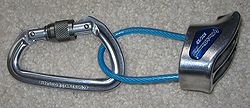Carabiner

A carabiner is a metal loop, which can be opened on one side. This side is called a gate. The other side is called spine. Carabiners are often used for rock climbing, sailing and canoeing. They also are used for construction of high buildings or window cleaning. The word comes from the German word "Karabinerhaken", which means "hook for a carbine".
Climbing carabiners are very strong. Many can hold loads greater than 20 kN. When belaying a climber, using a belay device (such as a Grigri or an ATC), a carabiner with a locking feature must be used to prevent the carabiner from opening accidentally.
Different types
- HMS: A special kind of carabiner is often used in rock climbing. HMS = HeMi Spherical. i.e. offset, or curved to one side. HMS is also considered short for the German word, "Halbmastwurfsicherung", a knot which is called the Munter Hitch in English. The special offset shape of the HMS carabiner allows a climber to use the Munter Hitch for belaying without the rope getting stuck or jammed.
- D-shape: This type of carabiner sends most of the load to the spine side. This makes the carabiner stronger, but more expensive. Big D-shape carabiners are called Offset-D
- Oval: This type is the cheapest. They are often used in aid climbing or for organizing (racking) gear. They are usually not as strong as the other types of carabiners.
The last two types exist with and without locking devices. HMS carabiners usually are not produced without locking device. Non-locking-carabiners are often used in quickdraws.
| Wikimedia Commons has media related to Lua error in Module:Commons_link at line 62: attempt to index field 'wikibase' (a nil value).. |
Carabiner Media
Carabiner with multiple combined auto lock and quick release, useful in via ferrata and arborist work, where two lanyards and carabiners are used






